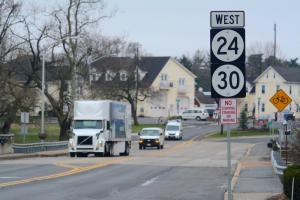A controversial $800 million plan for a Route 113 project to alleviate traffic congestion in and around Millsboro has been withdrawn. In its place, officials have proposed a scaled-down plan featuring a shorter, two-lane bypass, and in-alignment improvements along the Route 113 corridor.
Dozens of Millsboro residents packed the April 6 Millsboro Town Council meeting as Sen. Gerald Hocker, R-Ocean View, and state transportation officials unveiled the proposal.
The new plan features:
• A third lane and intersection improvements as needed along Route 113 from Millsboro to the Maryland line. Route 113 will not be a limited-access road under the proposed plan.
• A two-lane bypass of Millsboro connecting Route 24 to Route 113 crossing Hollyville Road, Route 30 and Millsboro Pond near the Doe Bridge Nature Preserve. The new 2.75-mile road would have connections at Route 24 near the Mountaire plant and at Route 113 at Patriots Way outside Millsboro.
The proposed plan appears to be good news for hundreds of property owners: Under the 2013 plan, 353 properties would have been affected by roadwork with 71 relocations required. The new plan is expected to affect 60 properties and require six relocations.
“And most of those are minor right-of-way issues,” said Delaware Department of Transportation engineer George Spadafino.
Hocker: DelDOT listened to people
Millsboro is a major hub for tourist, truck and residential traffic, and almost everyone agrees that congestion is a major problem. What most haven't agreed on is a solution. After a decade of debate, Hocker told residents he sees a light at the end of the tunnel. The plan proposed in 2013 was rejected by every Sussex County legislator, he said.
Hocker said he wanted town council members to see the latest plan before it started the long agency-review process and before public hearings could be scheduled. “I didn't want you to be blindsided,” he told council. “This plan includes everything asked for by Sussex County legislators, and I think DelDOT listened to the people of Millsboro.”
Hocker said traffic congestion has reached the point that it's hurting businesses. “And people are learning to stay away from Millsboro at certain times.”
Because the item was included on the agenda, town hall was packed to overflowing with residents who wanted to see the newest version of the plan.
DelDOT officials told those in attendance that they would have opportunities to comment on the plan during hearings that will take place during the summer.
Cost, scope reduced dramatically
The plan rolled out to the public in 2013 was met with strong opposition, Hocker said. “Sussex legislators were not happy with where the route was going, and we made it clear there would never be funding for that project,” Hocker said.
That plan was the end result of 30 proposed alternatives and eight rounds of public workshops dating back to June 2004.
Hocker said DelDOT went back to the drawing board and modified the plan with significant changes. At the top of the list of changes is cost of the two plans. The estimated cost of the 2013 plan was $800 million. The proposed bypass would cost about $50 million, said Shante Hastings, DelDOT's deputy director for transportation solutions.
Additional funds would be needed for improvements for Route 113, Hastings said. “It will still end up much less than $800 million,” Hastings said.
Hastings said the previous plan's 16.5-mile, four-lane, limited access Route 113 bypass was eliminated; the connector road – now the bypass – was reduced from four lanes to two lanes and the interchange planned at the bypass-Route 30 intersection has been changed to an at-grade intersection.
“At the time, we thought it would take a full-blown, off-alignment project to qualify for federal funds,” said Geoff Sundstrom, DelDOT's director of communications. “Now the feds are amenable to a different approach.”
With most federally funded projects, the Federal Highway Administration provides 80 percent of the funding and the state provides 20 percent. But to acquire that funding, projects must pass public muster.
Agency review before public hearings
Spadafino said the new plan is conceptual. “It's not an official alignment until it's reviewed by the environmental agencies, but we feel this is the most logical choice,” he said.
The proposed plan will be reviewed this spring by the Army Corps of Engineers, U.S. Fish & Wildlife Service, Environmental Protection Agency, Delaware Department of Natural Resources and Environmental Control and Delaware Historic Preservation Office.
A public workshop will be scheduled in July or August. Another hearing will take place once the final environmental impact statement has been published.
DelDOT officials will request a record of decision from federal highway officials in early 2016. If the project is eligible for federal funding, it will be ranked by DelDOT based on several factors including safety and congestion factors. It would then be added to the six-year capital transportation program subject to funding.
DelDOT officials said if funding was allocated to the project, it would take at least five years for design, right-of-way purchases and permit allocation before construction could begin. Spadafino said a best-case scenario estimate for construction would be 2020 or 2021.




















































